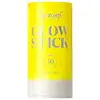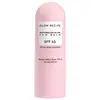What's inside
What's inside
 Key Ingredients
Key Ingredients

 Benefits
Benefits

 Concerns
Concerns

 Ingredients Side-by-side
Ingredients Side-by-side

Butyl Methoxydibenzoylmethane 3%
UV AbsorberEthylhexyl Salicylate 5%
UV AbsorberOctocrylene 10%
UV AbsorberC12-15 Alkyl Benzoate
AntimicrobialCalendula Officinalis Extract
Skin ConditioningCalophyllum Inophyllum Seed Oil
AntimicrobialCaprylic/Capric Triglyceride
MaskingDibutyl Ethylhexanoyl Glutamide
Skin ConditioningDibutyl Lauroyl Glutamide
Skin ConditioningDicaprylyl Carbonate
EmollientDiethylhexyl Syringylidenemalonate
Skin ProtectingHelianthus Annuus Seed Oil
EmollientIsododecane
EmollientIsohexadecane
EmollientLimnanthes Alba Seed Oil
Skin ConditioningMauritia Flexuosa Fruit Oil
Skin ConditioningOctyldodecanol
EmollientPentaclethra Macroloba Seed Oil
EmollientPolyester-8
Skin ConditioningTocopherol
AntioxidantButyl Methoxydibenzoylmethane 3%, Ethylhexyl Salicylate 5%, Octocrylene 10%, C12-15 Alkyl Benzoate, Calendula Officinalis Extract, Calophyllum Inophyllum Seed Oil, Caprylic/Capric Triglyceride, Dibutyl Ethylhexanoyl Glutamide, Dibutyl Lauroyl Glutamide, Dicaprylyl Carbonate, Diethylhexyl Syringylidenemalonate, Helianthus Annuus Seed Oil, Isododecane, Isohexadecane, Limnanthes Alba Seed Oil, Mauritia Flexuosa Fruit Oil, Octyldodecanol, Pentaclethra Macroloba Seed Oil, Polyester-8, Tocopherol
Butyl Methoxydibenzoylmethane 3%
UV AbsorberHomosalate 5%
Skin ConditioningEthylhexyl Salicylate 5%
UV AbsorberNeopentyl Glycol Dicaprylate/Dicaprate
EmollientOctyldodecanol
EmollientC15-19 Alkane
SolventCoco-Caprylate/Caprate
EmollientSilica Silylate
EmollientButyloctyl Salicylate
Skin ConditioningPolyester-8
Skin ConditioningDibutyl Lauroyl Glutamide
Skin ConditioningSqualane
EmollientCapryloyl Glycerin/Sebacic Acid Copolymer
Skin ConditioningDibutyl Ethylhexanoyl Glutamide
Skin ConditioningVp/Eicosene Copolymer
Tocopheryl Acetate
AntioxidantCitrullus Lanatus Seed Oil
EmollientParfum
MaskingPentaerythrityl Tetra-Di-T-Butyl Hydroxyhydrocinnamate
AntioxidantTetrahexyldecyl Ascorbate
AntioxidantCaprylic/Capric Triglyceride
MaskingLimnanthes Alba Seed Oil
Skin ConditioningGlyceryl Behenate
EmollientSodium Hyaluronate
HumectantNiacinamide
SmoothingCrithmum Maritimum Extract
Skin ConditioningButyl Methoxydibenzoylmethane 3%, Homosalate 5%, Ethylhexyl Salicylate 5%, Neopentyl Glycol Dicaprylate/Dicaprate, Octyldodecanol, C15-19 Alkane, Coco-Caprylate/Caprate, Silica Silylate, Butyloctyl Salicylate, Polyester-8, Dibutyl Lauroyl Glutamide, Squalane, Capryloyl Glycerin/Sebacic Acid Copolymer, Dibutyl Ethylhexanoyl Glutamide, Vp/Eicosene Copolymer, Tocopheryl Acetate, Citrullus Lanatus Seed Oil, Parfum, Pentaerythrityl Tetra-Di-T-Butyl Hydroxyhydrocinnamate, Tetrahexyldecyl Ascorbate, Caprylic/Capric Triglyceride, Limnanthes Alba Seed Oil, Glyceryl Behenate, Sodium Hyaluronate, Niacinamide, Crithmum Maritimum Extract
 Reviews
Reviews

Ingredients Explained
These ingredients are found in both products.
Ingredients higher up in an ingredient list are typically present in a larger amount.
Also known as Avobenzone, this ingredient is a chemical sunscreen filter that provides protection in the UV-A range.
Avobenzone is globally approved and is the most commonly used UV-A filter in the world.
Studies have found that avobenzone becomes ineffective when exposed to UV light (it is not photostable; meaning that it breaks down in sunlight). Because of this, formulations that include avobenzone will usually contain stabilizers such as octocrylene.
However, some modern formulations (looking at you, EU!) are able to stabilize avobenzone by coating the molecules.
Avobenzone does not protect against the UV-B range, so it's important to check that the sunscreen you're using contains other UV filters that do!
The highest concentration of avobenzone permitted is 3% in the US, and 5% in the EU.
Learn more about Butyl MethoxydibenzoylmethaneThis ingredient is an emollient, solvent, and texture enhancer. It is considered a skin-softener by helping the skin prevent moisture loss.
It helps thicken a product's formula and makes it easier to spread by dissolving clumping compounds.
Caprylic Triglyceride is made by combining glycerin with coconut oil, forming a clear liquid.
While there is an assumption Caprylic Triglyceride can clog pores due to it being derived from coconut oil, there is no research supporting this.
Learn more about Caprylic/Capric TriglycerideWe don't have a description for Dibutyl Ethylhexanoyl Glutamide yet.
We don't have a description for Dibutyl Lauroyl Glutamide yet.
Ethylhexyl Salicylate is an organic compound used to block UV rays. It primarily absorbs UVB rays but offers a small amount of UVA protection as well.
Commonly found in sunscreens, Ethylhexyl Salicylate is created from salicylic acid and 2-ethylhexanol. You might know salicylic acid as the effective acne fighter ingredient and BHA.
The ethylhexanol in this ingredient is a fatty alcohol and helps hydrate your skin, similar to oils. It is an emollient, which means it traps moisture into the skin.
According to manufacturers, Ethylhexyl Salicylate absorbs UV wavelength of 295-315 nm, with a peak absorption at 307-310 nm. UVA rays are linked to long term skin damage, such as hyperpigmentation. UVB rays emit more energy and are capable of damaging our DNA. UVB rays cause sunburn.
Learn more about Ethylhexyl SalicylateLimnanthes Alba Seed Oil is the oil extracted from the seeds of the meadowfoam plant. This oil is non-fragrant and is an emollient. As an emollient, meadowfoam seed oil helps soften and hydrate the skin.
Meadowfoam seed oil is stable and has a long shelf life due to its chemical structure. It has the highest concentration of stable fatty-acids among plant oils, preventing it from degrading once exposed to oxygen.
Due to the fatty acid content, this ingredient may not be fungal-acne safe.
Meadowfoam is native to California and Oregon.
Learn more about Limnanthes Alba Seed OilOctyldodecanol is a fatty alcohol. It is primarily used to enhance the texture of products.
As an emulsifier, Octyldodecanol helps prevent the oils and waters from separating. It also prevents ingredients from creating foam when shaken.
Octyldodecanol is created by reducing fatty acid to an alcohol.
Due to its high molecular weight, it does not get absorbed into the skin.
Learn more about OctyldodecanolThis ingredient is also known as Polycrylene. It is a UV photostabilizer and often used in sunscreens as an alternative to octocrylene.
Polycrylene is used to stabilize other UV filters, especially avobenzone, which is known to degrade rapidly without stabilizers. It also absorbs UVB light, but is only about 1/3 as effective as octocrylene.
At its maximum recommended strength of 4%, this ingredient is not likely to make a significant contribution to SPF factor. Polycrylene has a large molecular weight so it's unlikely to penetrate skin.
Although rare, this ingredient can cause contact dermatitis.
Due to regulatory loopholes, you'll be able to find this chemical UV filter in "100% mineral" sunscreens.
Learn more about Polyester-8